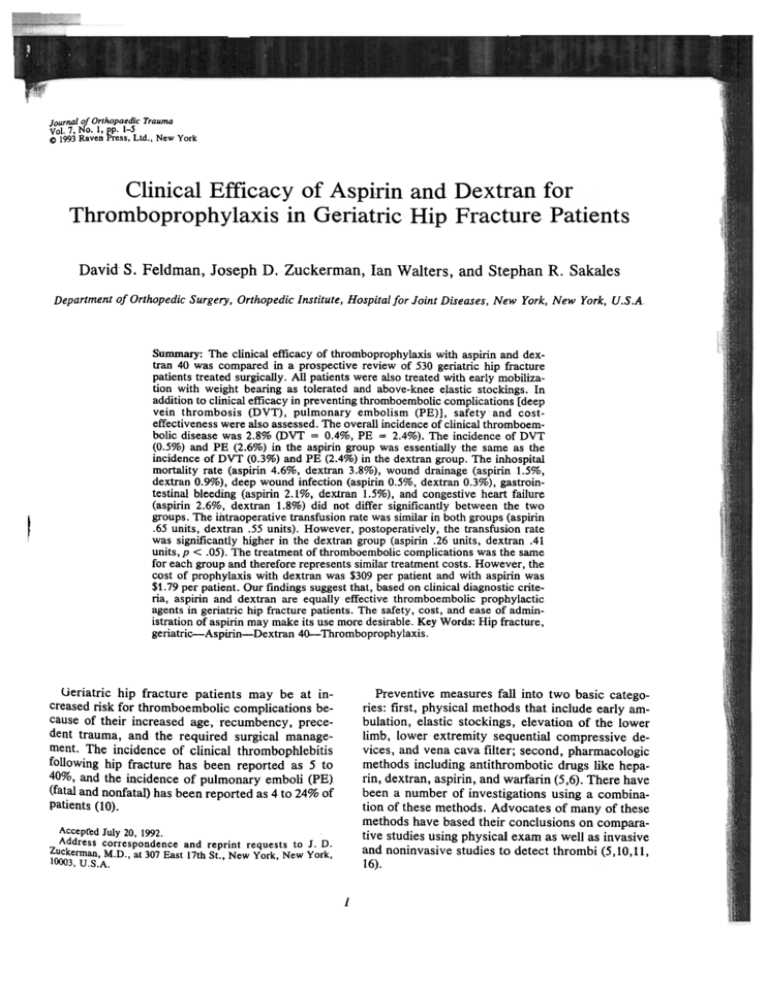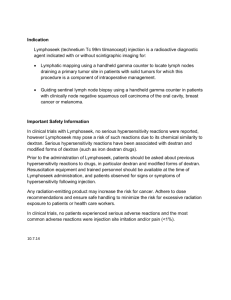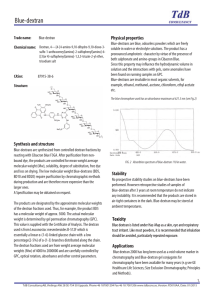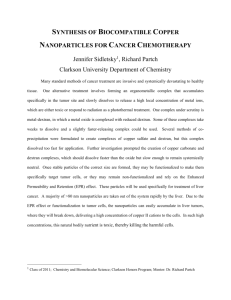David S. Feldman, Joseph D. Zuckerman, Ian Walters, and Stephan
advertisement

Journal of Orthopaedic Trauma
Vol.7. No.1. pp. 1-5
Ci 1993Raven Press. Ltd., New York
David S. Feldman, Joseph D. Zuckerman, Ian Walters, and Stephan R. Sakales
Departmentof OrthopedicSurgery, OrthopedicInstitute, Hospitalfor Joint Diseases,New York,New York, U.S.A
Summary: The clinical efficacy of thromboprophylaxis with aspirin and dextran 40 was compared in a prospective review of 530 geriatric hip fracture
patients treated surgically. All patients were also treated with early mobilization with weight bearing as tolerated and above-knee elastic stockings. In
addition to clinical efficacy in preventing thromboembolic complications [deep
vein thrombosis (DVT), pulmonary embolism (PE)], safety and costeffectiveness were also assessed.The overall incidence of clinical thromboembolic disease was 2.8% (DVT = 0.4%, PE = 2.4%). The incidence of DVT
(0.5%) and PE (2.6%) in the aspirin group was essentially {he same as the
incidence of DVT (0.3%) and PE (2.4%) in the dextran group. The inhospital
mortality rate (aspirin 4.6%, dextran 3.8%), wound drainage (aspirin 1.5%,
dextran 0.9%), deep wound infection (aspirin 0.5%, dextran 0.3%), gastrointestinal bleeding (aspirin 2.1%, dextran 1.5%), and congestive heart failure
(aspirin 2.6%, dextran 1.8%) did not differ significantly between the two
groups. The intraoperative transfusion rate was similar in both groups (aspirin
.65 units, dextran .55 units). However, postoperatively, the transfusion rate
was significantly higher in the dextran group (aspirin .26 units, dextran .41
units, p < .05). The treatment of thromboembolic complications was the same
for each group and therefore represents similar treatment costs. However, the
cost of prophylaxis with dextran was $309 per patient and with aspirin was
$1.79 per patient. Our findings suggestthat, based on clinical diagnostic criteria, aspirin and dextran are equally effective thromboembolic prophylactic
agents in geriatric hip fracture patients. The safety, cost, and ease of administration of aspirin may make its use more desirable. Key Words: Hip fracture,
geriatric--Aspirin-Dextran
40- Thromboprophylaxis.
Ueriatric hip fracture patients may be at increasedrisk for thromboembolic complications because of their increased age, recumbency, precedent trauma, and the required surgical management. The incidence of clinical thrombophlebitis
following hip fracture has been reported as 5 to
40%, and the incidence of pulmonary emboli (PE)
(fatal and nonfatal) has been reported as 4 to 24% of
patients (10).
Preventivemeasuresfall into two basic categories: first, physicalmethodsthat include early ambulation, elastic stockings, elevation of the lower
limb, lower extremity sequentialcompressivedevices, and vena cava filter; second,pharmacologic
methodsincluding antithrombotic drugs like heparin, dextran,aspirin, and warfarin (5,6).There have
beena number of inve.stigationsusing a combination of thesemethods.Advocatesof many of these
methodshavebasedtheir conclusionson comparative studiesusingphysical examas well as invasive
and noninvasivestudiesto detect thrombi (5,10,11,
16).
Accepfed July 20, 1992.
Address correspondence and reprint requests to J. D.
Zuckennan.
M.D.,
10003, U.S.A.
at 307 East
17th St.,
New
York,
New
York,
1
D. FELDMAN
ET AL.
2
Dextran 40 is a branched polysaccharide that
contains D-glucose units in a predominantly 1-6
linkage. It promotes a dissolution of thrombi without significantly altering the function of coagulation
factors contained in plasma. This is accomplished
by decreasing blood viscosity, inhibiting aggregation of platelets, and coating vascular endothelium.
The complications associated with dextran 40 therapy include volume overload with a potential risk of
congestive heart failure, anaphylaxis, and acute renal failure (9).
Aspirin in low doses «1000 mg per day) interferes with platelet function by blocking the production of thromboxane A2. Complications of aspirin
use include gastrointestinal bleeding and wound hematoma (9,14).
We evaluated the efficacy, safety, and cost of
thromboembolic prophylaxis used in out ho$pital
between August 1985 and June 1990 following hip
fracture in the geriatric population. The purPose of
this study was to compare the efficacy, saf~ty, and
cost of thromboprophylaxis regimens used in the
treatment of geriatric hip fracture patients.
MATERIALSAND METHODS
All patients admitted 10 the Hospital for Joint
DiseasesbetweenAugust 1985and June 1990for
the treatmentof a fracture of the proximal femur
were evaluatedfor inclusion in the study. For inclusion,patientshad to be ~65 years of age with a
fracture of nonpathologicalorigin; ambulatorybe~
fore fracture with or without assistivedevices;sufficiently cognitivelyintact to participate in the postoperativerehabilitationprogram;have no history of
thromboembolicevents [deep venous thrombosis
(PVT) and PE]; and have received postoperative
thromboprophylaxisconsistingof eitherdextran40
or tow dose aspirin combined with early weightbearingambulationand elastic stockings.
Patientswho met these criteria were followed
prospectively,andall pertinentinformationwas entered into a computerizeddatabase.Patientswere
divided into two groupsbased on the thromboprophylactic regimenutilized: dextran 40 versus low
doseaspirin.The regimenchosenwas not randomized but was basedon the surgeon'spreference.In
general,aspirinwas avoided in patients with a history of peptic ulcer dtsease or gastrointestinal
bleeding;and dextran 40 was avoided in patients
with a history of congestiveheart failure, pulmonary edema, or significant cardiac insufficiency.
J Or/hop
lrauma,
Vot.7,
:1993
i::,;"
However, the most important factor determining
the choice of thromboprophylaxis was surgeons'
preference.
The dextran 40 group received 50 g of dextran 40
in 300 to 500 cc of saline administered i. v. during
surgery followed by a similar dose daily until the
day of discharge. The aspirin group received ~325
mg in tablet form starting on the day of surgery until
the day of discharge. On postoperative day one, the
patients were mobilized out of bed to chair. Weight
bearing as tol~rated with ambulation was started on
postoperative day two. This early mobilization pro.
gram was followed in the majority of cases.
Changes in this approach were required in a small
percentage of patients and generally included those
who required monitoring in the intensive care unit
during the early postoperative period.
During the hospitalization, all patients were examined daily by the orthopaedic staff. When DVT
was suspected clinically, a venogram was ordered.
If a PE was suspected, a v'entilation/perfusion scan
was obtained. If this was il;1conclusive,a pulrt1onary
angiogram was performed. If a diagnosis of' either
DVT or PE was confirmed, the patient was started
on heparin anticoagulation followed by conversion
to oral warfarin. Coagulation status was followed
by serial'partial thromboplastin time and prothrombin time. Patients were allowed to resume ambulation after adequate anticoagulation was obtained.
The treatment of thromboembolic complications
was the same for both thromboprophylaxis groups.
In addition to the prospective data collection, the
charts of all patients with DVT or PE were carefully
reviewed to ascertain the details of treatment.' Statistical analysis was performed using the chi-square
test with Yate's correction to evaluate for significance.
RESULTS
A total of 530 patients fulfilled the criteria for
inclusion in this study: 338 in the dextran 40 group
and 192 in the aspirin ~oup. Each group was characterized with respect to multiple prefracture hospitalization characteristics including age, sex, number of co-morbid conditions, number of medications, length of surgery, anesthetic type, surgery
type, and hospital length of stay. This data is summarized in Table 1. There were no significant differences between the two groups except for the
number of co-morbid conditions, which was gre;ater
in the aspirin group (p < .004).
3
ASPIRIN VS. DEXTRAN FOR THROMBOPROPHYLAXISIN GERIATRIC HIP FRACTURE
TABLE 2. Morbidity and mortality
TABLE 1. Patient characteristics
Dextran40
Average age
No. patients
No. men
No. women
Average length of
surgery
Average no. of
co-morbid conditions
Average ASA rating
Average length of
stay in hospital
Fracture type
Femoral neck
Intertrochanteric
Surgerytype
DRIP
Endoprosthesis
--
Aspirin
---
NS
66 (19.5%)
272 (80.5%)
80.7
192
33 (17.2%)
159 (82.8%)
118.5min
114.0 min
NS
1.82
(p < .05)
2.29
NS
79.6
338
1.46
2.25
22.2days
24.0days
174(51.5%) 93 (48.4%)
164 (48.5%)
99 (51.6%)
203 (60.1%) 134 (69.8%)
135 (39.9%)
58 (30.2)
n = 338
n = 192
Dextran 40 (%)
Aspirin (%)
-~
DVT
NS
NS
NS
NS, not significant; ORIF, open reduction-internal fIXation,
Thromboembolic complications were similar in
eachgroup. The incidence of thrombophlebitis was
0.3% in the dextran group and 0.5% in the aspirin
group. Nonfatal PE occurred in 1.5% of the dextran
group and 0.5% of the aspirin group (p < .05). Fatal
PE occurred in 0.9% of the dextran group and 2.1%
of the aspirin group. This difference was not statistically significant. Total inhospital mortality was
3.8% in the dextran group and 4.6% in the aspirin
group (p > .05). Analysis of this data for men and
women within each group also did not show any
significant differences for thromboembolic complications.
The medical records of a1l22patients Who died in
the hospital were reviewed. The cause of death was
determined by clinical information; no autopsies
were performed. Of the~e 22 patients, the cause of
deathwas PE in four and other nonthromboembolic
complications in 15 patients. There were three patients for whom a cause of death could not be established. Two of these patients were in the aspirin
group and one in the dextran group. These deaths
were considered secondary to thromboembolic
complications so that we would not be underestimating the incidence of fatal PEs. These results are
summarized in Table 2.
Complications most commonly associated with
aspirin used included gastrointestinal bleeding and
mild renal insufficiency. Dextran may cause volume
overload (congestive heart failure), renal failure,
and anaphylaxis. Comparison of the incidence of
these complications and others between th.e two
grOUpSshowed no significant difference (Table 3).
The intraoperative transfusion rate was similar in
1 (0.5)
1 (0.6)
Clinical PE
FatalPE
Deaths
4 (2.1)
9 (4.6)
NS
NS
NS
NS
DVT. deep vein thrombosis;NS, not significant; PE, pulmonary embolism.
both groups (aspirin .65 units, dextran .55 units).
However, the postoperative transfusion rate was
sig~cant1y greater in the dextran group (aspmn
.26 units, dextran .41 units, p < .05).
The treatinent of thromboembolic complications
was essentially the same in the two groups. Intravenous heparin therapy was started immediately at
a dose that maintained the partial thromboplastin
time to two times control Coumadin was,begun 3 to
5 days later and maintained at a dose to elevate the
prothrombin time to 1V2times control. The cost for
the treatment of this complication was essentially
the same for both groups.
However, based on the average hospital length of
stay for each group, the cost of prophylaxis was
$309 for dextran and $1.79 for aspirin. The cost estimates include the dru~, i,v. fluid, tubing, and angiocatheter. However, the estimate did not include
personnel costs associated with administratio~ of
the medication or caring for and changingi. v. lines,
which would obviously be significantly greater for
the dextran group.
DISCUSSION
The incidenceand significanceof thromboembolic complicationfollowing hip fracture has been a
frequentsubjectin the literature over the pastthree
decades.In general...
the reports have beenvariable
and confusing,especiallyconcerningthe incidence
of thesecomplications. It has beenassumedsince
the autopsy study of Sevitt and Gallagherin 1959
TABLE 3. Complications
Dextran40
(%)
Incidenceof CHF
Incidenceof 01 Bleed
Superficialwound drainage
Deepinfection
Anaphylaxis
6 (1.8)
5 (1.5)
3 (0.9)
1 (0.3)
0
Aspirin
(%)
NS
NS
NS
NS
NS
CHF, congestiveheart failure; 01, gastrointestinal;NS, not
significant.
J Or/hopTmuma.Vol. 7. No.1. 1993
4
D. FELDMANETAL.
..
that prophylactic anticoagulation treatment was required in hip fracture patients to reduce the reported 18% incidence of PE and 29% incidence of
DVT to 2% and 3%, respectively, with prophylaxis
(17). One of the reasons confusion exists is that
some studies have documented the incidence of
asymptomatic and symptomatic thrombi while others have reported only symptomatic thrombi. For
example, Johnsson (12) reported a 12% incidence of
symptomatic DVT while Bergqvist (4) found a 64%
incidence of asymptomatic DVT. Neither study
used prophylaxis. Recently, Lotke and Day have
questioned the need for antithrombic prophylaxis.
They cite a low incidence of clinically significant
DVTs and PEs «1%) in untreated patients and
question the risk-benefit ratio for prophylaxis with
~20% wound complication rate with the use of warfarin or dextran. They also question the causative
relationship between DVT and PE (8,13).
When prophylaxis has been used, the effectiveness of the different regimens has been variable.
Alho compared aspirin, warfarin, and heparin in a
prospective randomized trial utilizing clinical diagnosis as the indication for venography or V/Q scan.
He found warfarin (DVT 2,5%, PE 0.5%) and aspirin (DVT 3%, PE 0.5%) equally effective and only
marginally better than heparin (DVT 4.2%, PE
2.1%) in preventing PE (2). Other studies have reported conflicting data with the use of aspirin (2,7,
10). Although some reports have demonstrated the
effectiveness of dextran, other authors have reported a mean incidence of 8.5% for DVT and 3%
for PE with the use of dextran. However, these
results were significantly better than the incidence
of thromboembolic complications found in their
control groups (1,3,10,12,15).
Our results demonstrate a low incidence of
thromboembolic complications compared to other
reports. This was true for both treatment regimens.
Recognition of the importance of early mobilization
starting on the first postoperative day with weight
bearing as tolerated thereafter may be one reason
for the decreased incidence of thromboembolic
complications when comparing studies from the
1960s and 1970s in which mobilization was often
delayed. In addition, our incidence of DVT was
based on the clinical suspicion of DVT which may
have resulted in an underestimation. However, our
incidence of fatal PE may be overestimated because
we included all suddendeaths of unknown cause in
this category. Although both treatment groups had
a low incidence of thromboembolic complications,
J Or/hop Trauma, Vol. 7, No.1. 1993
this study did not include patients without prophylaxis. An important treatment group for comparison
would be early mobilization and antiembolic stockings without prophylaxis.
The incidence of complications of treatment Was
low in each treatment group- Overall, only 2.1%
developed congestive heart failure and 1.9% developed gastrointestinal bleeds. Becausethis was not a
randomized study, the choice of dextran or aspirin.
was made by the surgeon. In general, -.
[
had a history of congestive heart failure, aspirin was
used.
The increased transfusion rate postoperatively in
the dextran group may be due either to increased
postoperative bleeding in the dextran treated pa.
tients or possibly to hemodilution with dextran and
therefore unnecessary transfusions.
It is important to emphasize that although all data
in this study were collected prospectively, it was
not a prospective randomized study. The decision
to utilize aspirin or dextran was based on surgeon
preference, which reflects an inherent bias. Better
methodology would have been to utilize a prosJ.}ective randomized study design including an objective
assessmentof thrombophlebitis (i.e., venogram, ul.
trasounQ, etc.). A design of this type would be ex.
pected to produce stronger and more incisive con.
clusions than the present study.
Based on the clinical results reported, aspirin is
as effective as dextran 40 for prophylaxis in geriat.
ric hip fracture patients. Dextran 40 has not gained
wide acceptance because of its high cost, need for
i. v. administration, and potential for side effects.
Aspirin is better accepted and relatively free from
side effects. Considering the added costs and dis-.
comfort associated with dextran administration as
well as th~. increased transfusion rate in these patients, it is our feeling that aspirin is preferred over
dextran 40 for thromboprophylaxis in geriatric hip
fracture patients.
REFERENCES'
1. Ahlberg A, Nylander G, Robertson 8, et aI.: Dextran in
prophylaxis of thrombosis in fractures of the hip. Acta Chi,
Scand 387:83-85, 1968.
2. Alho A, Strangeland L, Rottingen J, Wiig IN: Prophylaxis of
venouS-thromboembolism by aspirin, warfarin and heparin
in patients with hip fracture. Ann Chir Gynaecol73:225-228,
1984.
3. Atik M, Harkess JW, Wichman H: Prevention of fatal pulmonary embolism. Surg Gynecol Obstet 130:403-413,1970.
4. Bergqvist D, Efsing HO, HaIlbook T, Hedlund T: Thromboembolism after elective and post traumatic hip sur-
ASPIRIN VS. DEXTRAN FOR THROMBOPROPHYLAXISIN GERIATRIC HIP FRACTURE
5.
6.
7.
8.
gery-A controlled prophylactic trial with dextran 70 and
low dose heparin. Acta Chir Scand 145:213-218, 1979.
Bergqvist D: Postoperative thromboembolism. Frequency,
etiology and prophylaxis. Berlin: Springer-Verlag, 1983:7985.
Brooks RL, Winslow MC, Kenmore PI: The week-old hip
fracture: indication for prophylactic use of a vena cava filter? Orthopedics 10:1287-1288,1987.
Channon GM, Wiley AM: Aspirin prophylaxis of venous
thromboembolic disease following fracture of the upper femur. Can J Surg 22:468-471, 1979.
Day L: Pulmonary embolism and deep vein thrombosis in
patients with hip fractures. In: Meyers MH, ed. Fractures of
the hip. Chicago: Year Book Medical Publishers, 1985:320-
Prophylaxis of deep-vein thrombosis after total hip replacement. J Bone Joint Surg [Am] 67:57-62, 1985.
12. Johnsson S, Bygdeman S, EliassonR: Effect of dextran on
postoperative thrombosis. Acta Chir Scand 387:8a-82, 1968.
13. Lotke PA, Day L: Prophylaxis against deep-vein thrombosis
[Letter]. JAMA 259:687-688, 1988.
14. Masotti G, Poggesi L, Galante 0, et al.: Differential inhibition of prostacyclin production and platelet aggregation by
aspirin. Lancet 2:1213-1216, 1979.
15. Myhre HE, Persson JE, Svensson B, et al.: Prevention of
thromboembolism with dextran 70 and heparin in patients
with femoral neck fractures. Acta Chir Scand 139:609-616,
342.
16. Salzman EW, Harris W: Prevention of venous thromboembolism in orthopaedic patients. J Bone Joint Surg [Am] 58:
9. Goodman LS, Gilman AG: The pharmacological basis of
therapeutics. New York: Pergamon Press, 1990.
10. Haake DA, Berkman S: Venous thromboembolic disease after hip surgery. Clin Orthop 242:212-231, 1989.
11. Harris W, Athanasoulis CA, Waltman AC, Salzman EW:
J
5
1973.
903-913,1976.
17. Sevitt S, Gallagher NO: Prevention of venous thrombosis
and pulmonary embolism in injured patients. Lancet 2:981,
1959.
J Orthop Trauma. Yo/. 7, No.1. 1993








